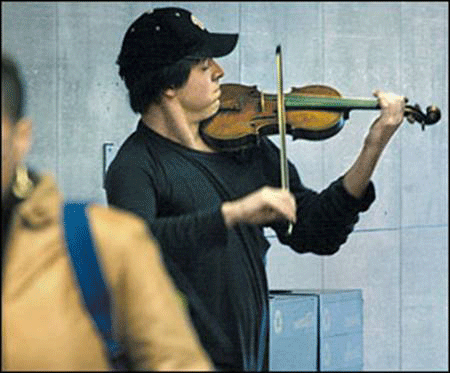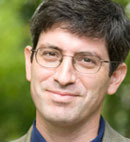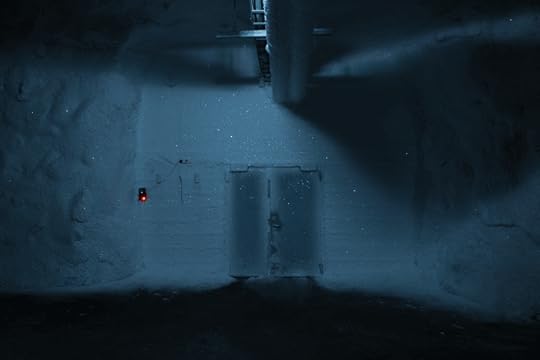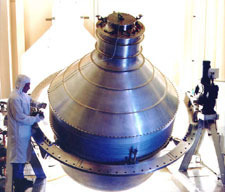Stewart Brand's Blog, page 102
May 19, 2011
The Thousand-Year Game Design Challenge
 Game Designer Daniel Solis has issued a challenge and he's backing it up with a cash bounty. $1,000 will go to whomever can come up with a thousand-year game:
Game Designer Daniel Solis has issued a challenge and he's backing it up with a cash bounty. $1,000 will go to whomever can come up with a thousand-year game:
Create a game. The game can be of any theme or genre you desire, but there is one restriction: You're creating a "new classic," like Chess, Tag or card games. So, create a game to be enjoyed by generations of players for a thousand years.
He's published 8 entries so far and will continue accepting them until July 31st 02011.
The winner will be announced January 1st 02012.
Entries so far derive inspiration from Go, Taboo, the myth of Pandora's Box, the Prisoner's Dilemma, and plenty of other stories and concepts. You can browse the published entrants by month:
January
February
March: (No entries)
April







May 18, 2011
The Floodgates of Fudai

While many Japanese towns were completely destroyed by the tsunami in March, several escaped potentially dire fates. Some villages were warned of the dangers of building too close to water by tablets and monoliths erected in the wakes of previous disasters.
According to this AP story, the village of Fudai took a technological brute-force approach, spearheaded by a previous mayor. Kotaku Wamura was mayor of Fudai for 10 terms and, during the 70s, fought city council resistance to augment a 51-foot tall seawall with flood gates of the same height. Wamura had witnessed the 1933 tsunami and was deeply affected by the devastation.
Fudai is fortunate to be located in a valley just narrow enough to be fortified against rising waters. The size and the expense of doing so put many off his plan, but in the end, Wamura won and the floodgates were finished in 1984.
The result last March was minimal damage, isolated mostly to the city's port, only one missing resident who insisted on checking his boat after the quake, and many new visitors paying respect and expressing gratitude at the grave of Mr. Wamura, who passed away in 1997.
Gawker blog Kotaku did a little digging of their own into Wamura and found a photograph of him, mention that his name means "good luck advantage" and point out some transliteration problems in the AP story.







May 17, 2011
Smart Night Out and Long Now explore "Quiet"
Smart Night Out, the new art happening from Yerba Buena Center for the Arts, explores the theme of Quiet on its inaugural night of Saturday May 28, 02011 from 7:00pm to 11:30pm. This event is free to attend when you RSVP.
Long Now was invited by YBCA to curate the screening room and we asked artist Steve Rowell to create a piece around his recent trip to the Svalbard Seed Vault with Long Now's Executive Director Alexander Rose.
Incidental Soundscapes: High and Low by Steve Rowell
Internationally exhibited artist Steve Rowell assembled field recordings from a recent trip to the Svalbard Global Seed Vault. This remote location proved to have a surprising soundtrack both natural and engineered. Kick back in our Screening Room with his audio-visual exploration of these aural landscapes and ponder the meaning of silence. An intermission piece will feature incidental ambience of the supersonic airspace of the Mojave desert.
At the Smart Night Out, inquisitive participants can dance to the Silent Disco, interact with the exhibits and building through a series of Movement Meditations, work with a deaf choreographer and experience more art and activities that expand around this theme of Quiet.
Also included is free entry into the three Visual Arts exhibits Song Dong, Euan Macdonald, and Daily Lives, food carts and a cash bar.







Do you have a moment… for pure genius?

Somehow I missed this story when it came out (even though it won a Pulitzer), but today I came across it at random on of all places Jeff Bridges website who wrote a fantastic synopsis. But as they say, the Dude abides:
Washington, DC Metro Station on a cold January morning in 2007. The man with a violin played six Bach pieces for about 45 minutes. During that time approx. 2 thousand people went through the station, most of them on their way to work. After 3 minutes a middle aged man noticed there was a musician playing. He slowed his pace and stopped for a few seconds and then hurried to meet his schedule.
4 minutes later:The violinist received his first dollar: a woman threw the money in the hat and, without stopping, continued to walk.
6 minutes:A young man leaned against the wall to listen to him, then looked at his watch and started to walk again.
10 minutes:A 3-year old boy stopped but his mother tugged him along hurriedly. The kid stopped to look at the violinist again, but the mother pushed hard and the child continued to walk, turning his head all the time. This action was repeated by several other children.. Every parent, without exception, forced their children to move on quickly..
45 minutes:The musician played continuously. Only 6 people stopped and listened for a short while. About 20 gave money but continued to walk at their normal pace. The man collected a total of $32.
1 hour:He finished playing and silence took over. No one noticed. No one applauded, nor was there any recognition.
No one knew this, but the violinist was Joshua Bell, one of the greatest musicians in the world. He played one of the most intricate pieces ever written, with a violin worth $3.5 million dollars. Two days before Joshua Bell sold out a theater in Boston where the seats averaged $100.
This is a true story. Joshua Bell playing incognito in the metro station was organized by the Washington Post as part of a social experiment about perception, taste and people's priorities.
The questions raised:*In a common place environment at an inappropriate hour, do we perceive beauty?
*Do we stop to appreciate it?
*Do we recognize talent in an unexpected context?
One possible conclusion reached from this experiment could be this:If we do not have a moment to stop and listen to one of the best musicians in the world, playing some of the finest music ever written, with one of the most beautiful instruments ever made.
How many other things are we missing?







May 16, 2011
Around the World in 10,000 Birds
Nearly 400 bird species can be found in the San Francisco Bay Area. In the state of California, there are more than 600 species. North America has 2,000. Zooming all of the way out, the earth is home to over 10,000 bird species. Many bird enthusiasts focus their attention on local avian populations–but, of course, the term 'local' is relative. Mike Bergin is the founder of 10,000 Birds and his approach is global in scope.
There are approximately 10,000 bird species on this beautiful planet. Here at 10,000 Birds we expect to not only see but eventually photograph or write about every single one! (We'll get there eventually…)
Anyway, we have a serious interest in photography to go with our interest in birds and bird identification. We've consequently amassed a rather large collection of photos, and rather than hide them away on our hard-drives we've decided that you may like to see them instead.
Few people are this truly holistic in their endeavors, but technology is increasing the plausibility of such earth-wide projects. An earlier post on this blog featured two efforts that would make good company for 10,000 Birds: the Encyclopedia of Life and International Barcode of Life. The Encyclopedia of Life seeks to create a single database with organized and concise information about every life form on the planet. The International Barcode of Life champions an efficient method of identifying species through DNA sequencing.
As massively parallel sequencing technologies become more available, the barcode library will enable sophisticated environmental monitoring that uses living organisms as integrators of environmental change and as early warnings of damage. Large-scale, automated monitoring of species presence and abundance in the world's oceans, inland waters, agro-ecosystems, and plantations will soon be routine.
Open collaboration and creative technologies provide opportunities for people to collectively analyze vast amounts of information, and through these efforts we get clearer glimpses of the big picture, the Big Here. 10,000 Birds is stitching their big picture out of a heck of a lot of smaller ones, and their glimpse of this beautiful hummingbird in Ecuador is lovely.







May 12, 2011
Distilling Science
 Living in modern civilization, it can be easy to sometimes forget just how much *stuff* we rely on to meet our basic needs and just how much scientific sweat and blood it's all taken to create. Bruce Mau illustrates this in the beginning of his book Massive Change by using the metaphor of modern air travel:
Living in modern civilization, it can be easy to sometimes forget just how much *stuff* we rely on to meet our basic needs and just how much scientific sweat and blood it's all taken to create. Bruce Mau illustrates this in the beginning of his book Massive Change by using the metaphor of modern air travel:
"Every plane crash is a rupture, a shock to the system, precisely because our experience of flight is so carefully designed away from the reality of the event. As we sip champagne, read the morning paper, and settle in before takeoff, we choose not to experience the torque, the thrust, the speed, the altitude, the temperature, the thousands of pounds of explosive jet fuels cradled beneath us, the infinite complexity of the onboard systems, and the very real risks and dangers of takeoff and landing."
The technological apparatus that is modern civilization, or The Technium as Kevin Kelly calls it, allows us to fly high in style. But, it's a complicated and often fragile mess designed to channel very powerful forces – and it can fail catastrophically if we aren't careful. Additionally, it's taken many generations of accumulated knowledge and expertise to craft and enable such soaring capability.
Referencing that hard-won store of knowledge, Richard Feynman once asked,
"If, in some cataclysm, all of scientific knowledge were to be destroyed, and only one sentence passed on to the next generations of creatures, what statement would contain the most information in the fewest words?"
Inspired by Feynman's question, Seed Magazine asked eleven scientists,
"Imagine—much as Feynman asked his audience—that in a mission to change everyone's thinking about the world, you can take only one lesson from your field as a guide. In a single statement, what would it be?"
Some interesting themes fall out, as well as some contradicting ideas:
Paul Ehrlich, Carl Folke and Enric Sala all point out the reciprocity between the human economy and the biosphere, in the seeming hope of illustrating our need to conceptualize the limits in which we as a species operate.
A psuedo-debate pops up between proponents and critics of reductionism. Robet Sapolsky, Steven Strogatz and George Sugihara weigh in.
Marc Hauser and Dominic Johnson assert the importance of understanding evolution's influence on our world and our selves.
It's an interesting challenge, to distill everything we've learned over the last few millennia into a useful sentence. Which theories have been most important? What details would we be most hard-pressed to re-discover? Perhaps the most all-encompassing answer comes from John Wilbanks, vice president of science at Creative Commons:
"Knowledge is a public good and increases in value as the number of people possessing it increases."
If pondering the essence of modern civilization and technology gets your gears going, don't miss the Manual for Civilization, a list of projects focused on preserving the technical knowledge it takes to build and maintain the infrastructure on which we depend collected by Long Now's Alexander Rose or Long Now Board Member Kevin Kelly's Library of Utility, a proposal to collect such knowledge, and to store it in a place that might have a reasonable chance of surviving the kind of catastrophe that would make its contents necessary. Also: this.







May 11, 2011
Long Now at Maker Faire and SETI
 Long Now Executive Director and 10,000 Year Clock Project Manager Alexander Rose will be speaking on the Maker Faire Center Stage at 12:30 on Sunday the 22nd.
Long Now Executive Director and 10,000 Year Clock Project Manager Alexander Rose will be speaking on the Maker Faire Center Stage at 12:30 on Sunday the 22nd.
Maker Faire is one of the Bay Area's biggest celebrations of geek culture and it's back for a 6th installment at the San Mateo Fairgrounds this May 21st & 22nd. Organized by O'Reilly Media, Maker Faire features hundreds of artists, engineers, designers and hackers sharing the things they make.
 Alexander is also speaking at the SETI Institute at noon on Wednesday May 18th.
Alexander is also speaking at the SETI Institute at noon on Wednesday May 18th.
In this talk, titled Construction on the 10,000 Year Clock Begins, he will discuss the process, principles and methods underlying the Clock of the Long Now. The SETI Institute Colloquium Series is held in Mountain View, and is free to the public.







May 10, 2011
Big Talk: The Possibilities of Large Linguistic Databases

Two language families' trees from Dr. Dunn's paper, with two word-order traits.
How does human language work? What are its possibilities and limitations? Where did it come from? Many linguists have asked these questions and made contributions to our understanding of language, but how do they get their answers?
One approach is to go out and document a language, which can then be compared to other languages, writings from the past, etc. Through various methods, linguists have succeeded in discovering patterns within and between languages that allow us to define some of their parameters and to organize them into families. But, as two recent publications demonstrate, our ability to recognize patterns—and their underlying causes—may be dramatically increasing with the development of technology that can centralize, organize and manipulate enormous amounts of information.
The two studies were highlighted in The Economist, and both of them offer conclusions that are likely to spark lively debate. Dr. Michael Dunn, from the Netherlands' Max Planck Institute for Psycholinguistics, published a paper in Nature magazine addressing word-order dependencies—the idea that, for example, if a given language places verbs before objects (eat lunch) it will also place prepositions before nouns (at home). By comparing different languages, linguists have found that there are some strong consistencies in these dependencies, indicating that they are the result of "underlying cognitive or systems biases." Dr. Dunn, however, has used large databases of basic vocabularies and statistical methods borrowed from evolutionary biology to approach the problem of dependencies in a different way:
To substitute for fossils, and thus reconstruct the ancient branches of the tree as well as the modern-day leaves, Dr Dunn used mathematically informed guesswork. The maths in question is called the Markov chain Monte Carlo (MCMC) method. As its name suggests, this spins the software equivalent of a roulette wheel to generate a random tree, then examines how snugly the branches of that tree fit the modern foliage. It then spins the wheel again, to tweak the first tree ever so slightly, at random. If the new tree is a better fit for the leaves, it is taken as the starting point for the next spin. If not, the process takes a step back to the previous best fit. The wheel whirrs millions of times until such random tweaking has no discernible effect on the outcome.
When Dr Dunn fed the languages he had chosen into the MCMC casino, the result was several hundred equally probable family trees. Next, he threw eight grammatical features, all related to word order, into the mix, and ran the game again.
He found that particular word-order traits were not necessarily linked to others in the way that current theories propose. Rather, such dependencies seemed to be 'lineage-specific,' suggesting that they have been passed down through language families. "Nurture, in other words, rather than nature," as The Economist put it.
The other article, published in Science by Dr. Quentin Atkinson of the University of Auckland, also uses statistics and databases in an innovative way. He looked at information from the World Atlas of Language Structures on sounds in different languages and found that phonemic diversity (the number of sounds used in a language) decreases as you follow the pathways of human migration outwards from central/southern Africa. The Science article argues that modern language originated in that part of Africa and that phonemic diversity decreased with every stage of human expansion as small groups of people set off in search of new territory.
Both of these studies utilize phylogenetic language groupings, based on evolutionary theory, and they run statistical analyses with large amounts of data made available by central repositories of linguistic information, such as the World Atlas of Language Structures. The Long Now Foundation's Rosetta Project is an effort to improve and facilitate that very sort of creative methodology—to organize and make available large amounts of data so that researchers can develop fundamentally new methods of inquiry.







May 9, 2011
Carl Zimmer Ticket Info
Seminars About Long-term Thinking

Carl Zimmer on "Viral Time"
TICKETS
Tuesday June 7, 02011 at 7:30pm Cowell Theater at Fort Mason
Long Now Members can reserve 2 seats, join today! • General Tickets $10
About this Seminar:
The frontier of biology these days is the genetics and ecology of bacteria, and the frontier of THAT is what's being learned about viruses. "The science of virology is still in its early, wild days," writes Carl Zimmer. "Scientists are discovering viruses faster than they can make sense of them." The Earth's atmosphere is determined in large part by ocean bacteria; every day viruses kill half of them. Every year in the oceans, viruses transfer a trillion trillion genes between host organisms. They evolve faster than anything else, and they are a major engine of the evolution of the rest of life. Our own bodies are made up of 10 trillion human cells, 100 trillion bacteria, and 4 trillion very busy viruses. Some of them kill us. Many of them help us. Some of them are us. Viral time is ancient and blindingly fast.
Science journalist Carl Zimmer's new book, A Planet of Viruses, is the best introduction to the subject. His previous books include Parasite Rex and Microcosm.
Twitter - up to the minute info on tickets and events
Long Now Blog – daily updates on events and ideas
Facebook – stay in touch through our fan page
Long Now Meetups - join one or start your own







Gravity Probe B Confirms Einstein's Predictions
Gravity Probe B is a satellite that, since 02004, has been conducting an experiment first conceived half a century ago with the goal of testing a theory developed another half-century before that.
Indeed, some of the predictions to come out of Albert Einstein's Theory of Relativity have taken until now – a century later – to test. Nonetheless, frame dragging has been observed and confirmed.
Wondering what took so long? The New York Times explains that the theory had largely been supported by observations of the planets, the Moon and other satellites, but that direct observation of such a subtle effect required some of the most sensitive instruments and precisely machines objects in history.
To measure these minuscule warps in the very fabric of spacetime, Gravity Probe B used the world's most perfect gyroscopes, monitored by the most precise gyro-monitors, kept directly oriented to a 'guide-star' using a telescope and an Attitude and Translation Control system, all maintained at exactly -455.5 degrees F for 16 months while it orbited the earth in a 400-mile high polar orbit.
More on the gyroscopes:
To measure the minuscule angles predicted by Einstein's theory, the GP-B team needed to build a near-perfect gyroscope—one whose spin axis would not drift away from its starting point by more than one hundred-billionth of a degree each hour that it was spinning. By comparison, the spin-axis drift in the most sophisticated Earth-based gyroscopes, found in high-tech aircraft and nuclear submarines, is seven orders of magnitude (more than ten million times) greater than GP-B could allow.
The rest of the satellite and it's mission are documented in luxurious detail on the project's website.







Stewart Brand's Blog
- Stewart Brand's profile
- 291 followers






